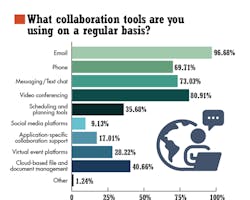A Hopeful Look Forward in 2022
This article is part of the 2022 Electronic Design Forecast issue
What you'll learn:
- How collaborative tools are becoming part of the work ecosystem.
- The evolving power technology space sparked by WBG semiconductors.
- The rise of edge computing and the cloud
The past few years have presented society with myriad challenges and developments—some good, some bad. Every community has been impacted by current events, and each has had to address the challenges in their own way. The electronics community was not isolated from the events sweeping the planet and has had to address these issues as well. The greatest benefit from overcoming these issues are the solutions created and their impact on the future.
The year 2022 promises nothing to no one, and none of us can predict what will happen in the coming year. However, trends and technologies are creating next-generation products and services that will positively impact this coming year and the ones following. These include the maturation of collaborative tools, the increasing adoption of wide-bandgap semiconductors, and the expansion of intelligent systems into every powered device.
Continued Expansion of Collaborative Tools
Collaborative software and connectivity in bench tools aren’t brand-new developments. These solutions have been around for years, but they were largely used by big widespread organizations and remote contractors. However, the pandemic situation created a “perfect storm” for collaborative tool adoption. The need to work remotely became a critical issue for many organizations, and they turned to connected hardware and collaborative software to address their telepresence problems (Fig. 1).
The ability to work remotely is just one of the benefits of such tools, and the real advantages became apparent once companies started using them. Beyond simple communication and file exchange, these tools also create a more organized and integrated design environment that delivers benefits across the board. For example, modern collaborative design software tracks all parts and components specified for a design, eliminating the need for an additional engineer just to create the bill of materials for the project.
These and other force-multipliers are not only enabling people to work together remotely, but also empowering the design process by completely integrating and digitizing all of the elements in a way that provides a flexible and capable real-time design ecosystem. When leveraged with smart manufacturing and Industry 4.0 capabilities, these collaborative tools can enable reiterative design—constantly tweaking a product during production to integrate and optimize every aspect that can be in a continuous process.
The upshot of all this is that collaborative hardware and software tools will not be put aside as people return to their offices, as the advantages of using them go far beyond the ability to work remotely. A digitized, integrated, and optimized design, development, and manufacturing process will continue to provide benefits to the electronic design industry long after the initial need for telepresence passes.
Initiated by isolation, collaborative tools will continue to expand in functionality and capability even as people are working side-by-side again.
Wide-Bandgap Power Will Change the World
Wide-bandgap (WBG) semiconductors have been coming to a slow boil for the last few years, as they slowly win over the electronic engineering community. The significant performance advantages of gallium-nitride (GaN) and silicon-carbide (SiC) products have been to a greater or lesser degree offset by their newness and additional cost over legacy silicon devices.
Using WBG devices as drop-in replacements can provide some performance advantages, too. However, to realize the full benefits, the power electronics must be redesigned, increasing adoption resistance.
This is another space where adoption has been impacted by the pandemic, giving WBG devices additional opportunity to show their mettle. The resulting disruption to the supply chain caused those with the resources to migrate their designs from legacy silicon to WBG discretes to ensure inventory. This in turn caused them to migrate their power electronic designs to more advanced topologies to take full advantage of WBG benefits.
The benefits of these new devices should not be taken lightly, as the wide energy difference in WBG semiconductors between the top of the valence band and the bottom of the conduction band enables them to operate at higher voltages, temperatures, and frequencies. These aspects not only improve power-management capability, they also can directly impact the performance of the systems involved. For example, the high switching frequency of GaN-based power supplies enable systems like LiDAR that rely on speed to flourish.
This migration of power electronics to WBG will not ease as the supply chain improves, since the benefits of GaN and SiC go far beyond their ability to simply replace silicon in a design. Their performance advantages are so profound that few who start using them go back to silicon unless their budget demands it. Even that price issue will fade as WBG availability continues to grow. 2022 may very well be the year that silicon is declared obsolete in power applications.
The Edge of the Cloud and Its Devices Will Get Way Smarter
Luckily the internet existed when the pandemic started, or we would all have gone stir crazy by now. (One wonders what people did when they were quarantined during the great flu epidemic.) The impact of the quarantines on people and the rise of importance of the internet in daily work and personal life migrated the venue from primarily entertainment to a vital part of our societal infrastructure, without which many today wouldn’t even know how to function. Social interactions became more dependent on telepresence as well.
Though the rise in the internet’s importance in society was impacted by the pandemic, its growth and expansion into our lives was already underway and is continuing apace. The cloud and Internet of Things (IoT) were already in existence and on their way to higher levels of functionality and penetration, so the situation “merely” sped up the process. Now people’s work and social lives revolve around the internet and its avatars.
The biggest trend for the future of the internet is the continued evolution of edge computing and more powerful IoT devices (Fig. 2). The migration of as much logic horsepower from the central server to as close to the user or server application as possible will continue until the industry reaches theoretical maximums. This evolutionary migration will continue to impact society in multiple ways for the foreseeable future.
Edge computing directly addresses multiple issues within the cloud, such as latency, bandwidth usage, and security. For example, in a security surveillance situation using facial recognition, performing first-level discrimination to pass probables to central control instead of a stream of wideband data saves everything from RF bandwidth to response time. Or using a smart robotic hand to reduce the amount of control needed from central logic, or performing sensor conditioning and fusion in a modular solution to reduce demands on the central processor.
Looking Forward
All of these trends are leveraging one another to create a more functional and capable societal infrastructure, empowering and enabling people and applications in new and interesting ways. Advanced connected design tools leveraging next-generation WBG power electronics, driving smart and versatile edge devices and systems, will continue to transform how we live, work, and recreate. These powerful trends are not only helping us deal with the current reality, but they will speed us on our way to the future.
Read more articles in the 2022 Electronic Design Forecast issue
About the Author
Alix Paultre's Archive
Editor-at-Large
Also check out Alix's main author page for his latest articles.
An Army veteran, Alix Paultre was a signals intelligence soldier on the East/West German border in the early ‘80s, and eventually wound up helping launch and run a publication on consumer electronics for the US military stationed in Europe. Alix first began in this industry in 1998 at Electronic Products magazine, and since then has worked for a variety of publications in the embedded electronic engineering space. Alix currently lives in Wiesbaden, Germany.
Also check out hjis YouTube watch-collecting channel, Talking Timepieces.



